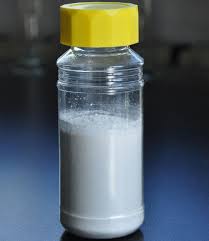Overview[1]
The English common name of tralkoxydim (BSI, ISO-Edraft); tralkoxydime (ISO-Fdraft) trade name Grasp; other names of Splendor Grasp604; ICIA0604; PP604 chemical name 2-[1-(ethoxyimino) 2-[1-(ethoxyimino)propyl]-3-hydroxy-5-mesitylcyclohexen-2-one , is a white, odorless crystal that can effectively control a variety of grass weeds in wheat fields, including wild oats, and is a highly selective herbicide.

Main properties
Tralkoxydim is a cyclohexenone herbicide and an inhibitor of acetyl-CoA carboxylase. After foliar application, it is quickly absorbed and transferred by the plant, and is transferred to the growth point in the phloem to inhibit new shoots. As the weeds grow, they first lose green, then change color and die, usually completely dead within 2 to 3 weeks. It is suitable for wheat and barley fields to mainly control wild oats, straw, cricket grass, cowgrass, wheatgrass, crabgrass and foxtail grass. and other annual grass weeds. Oxitrione has systemic conductivity and is used to control a variety of grass weeds in barley and wheat fields. After the pesticide is applied to the leaves, it is quickly absorbed and transferred to the whole body of the plant, causing the weeds to lose their green color and then die. The general spraying amount is 150~350g active ingredient/hm2. The dosage for controlling wild oat weeds is 200-350g/hm2, which is effective from the early growth stage to the leafing stage and jointing stage. In the existing technology, hydrotrione has certain limitations in practical application. It can only control gramineous weeds in wheat fields and has no significant activity against broadleaf weeds.
A large amount of waste liquid is produced every day during the production of hydrotrione, which is mainly acid/alkali waste liquid and contains a large amount of solid impurities. The usual treatment method is to collect it and conduct pollution-free treatment on a regular basis. The conventional treatment method is to pour the waste liquid into a basin for acid-base neutralization and then discharge it. Since there is no special equipment, the entire treatment process is completed by staff with bare hands. During this period, the acid/alkali waste liquid is neutralized and releases a lot of heat and a large amount of pungent acid gas, which will cause harm to human health. Solid impurities are removed Filtration is carried out. In addition, most acids and alkalis are highly corrosive, so there are also major safety hazards in the entire treatment process.
Apply[3]
Preparation of 70% flutrisulfuron-oximetrione water-dispersible granules:
Tritrisulfuron 60%, Oxitrione 10%, sodium butylnaphthalene sulfonate 5%, lignosulfonate 8%, sodium bicarbonate 2%, diatomaceous earth supplement 100%. Mix the above-mentioned active ingredients, dispersant, wetting agent, disintegrant and solid carrier evenly, crush it with an ultra-fine jet mill, knead it, and then add it to a fluidized bed granulation dryer for granulation, drying and screening. 70% flutrisulfuron-oximetrione water-dispersible granules can be prepared.
Preparation[2]
Condensate 2,4,6-trimethylformaldehyde with acetone, and the unsaturated ketone obtained reacts with diethyl malonate; the product is hydrolyzed, cyclized, and decarboxylated to obtain 3-hydroxy-5-( 2,4,6-trimethylphenyl)-cyclohex-2-en 1-one, this compound reacts with propionic anhydride in the presence of sodium methoxide to obtain 3-hydroxy-5-(2,4,6 -Trimethylphenyl)-2-propionyl-cyclohex-2-en-1-one; finally react with ethoxyamine hydrochloride to obtain the crude product of Oxitrione, which can be obtained after purification Oxitrione pure product; however, the pure product of Oxitrione obtained by current conventional purification methods is not high, only about 95%.
Purification method
Step 1, heat and dissolve the crude hydrotrione in a mixed solution of glycol dimethyl ether, triethanolamine, and ethyl acetate with a volume ratio of 2:2:1; the heating and dissolution temperature is 80-90°C;
Step 2, filter while hot, remove insoluble matter, and take the filtrate;
Step 3, add hexane to the filtrate obtained in step 2, the volume ratio of the filtrate to hexane is 1:0.8; continue heating and stirring, remove half of the solvent, filter while hot, remove insoluble matter, and take the filtrate ;
Step 4: Cool the filtrate obtained in step 3 to 10-20°C in 30-40 minutes, filter it with suction, and take the filter cake, which is pure hydrotrione with a purity of 99.8%.
Main reference materials
[1] Liu Fuhai, Xu Chengming, & Gao Ming. (2008). Test on the control of weeds in wheat fields with 75% hydrotrione·bromoxynil water-dispersible granules. Pesticides, 47(10), 773-774.
[2] Wu Wenzhu, Guo Min, He Jian, Kong Deyang, & Shan Zhengjun. . High performance liquid chromatography analysis method of alfatrione in environmental samples. Pesticides (11), 34-36.
[3] Weng Hua. (2011). Efficacy test of 75% oxitrione·bromoxynil wg for controlling weeds in spring wheat fields. Hubei Agricultural Sciences, 50(22), 4606-4608.

 微信扫一扫打赏
微信扫一扫打赏

